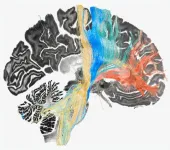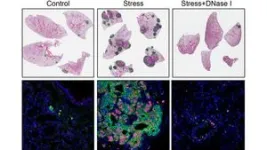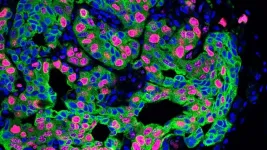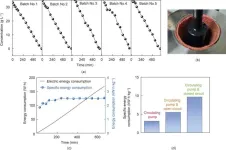(Press-News.org) A new study led by investigators from Mass General Brigham demonstrated the use of deep brain stimulation (DBS) to map a ‘human dysfunctome’ — a collection of dysfunctional brain circuits associated with different disorders. The team identified optimal networks to target in the frontal cortex that could be used for treating Parkinson’s disease, dystonia, obsessive compulsive disorder (OCD) and Tourette's syndrome. Their results are published in Nature Neuroscience.
“We were able to use brain stimulation to precisely identify and target circuits for the optimal treatment of four different disorders,” said co-corresponding author Andreas Horn, MD, PhD, of the Center for Brain Circuit Therapeutics in the Department of Neurology at Brigham and Women’s Hospital and the Center for Neurotechnology and Neurorecovery at Massachusetts General Hospital. “In simplified terms, when brain circuits become dysfunctional, they may act as brakes for the specific brain functions that the circuit usually carries out. Applying DBS may release the brake and may in part restore functionality.”
Connections between the frontal cortex in the forebrain and basal ganglia, structures located deeper in the brain, are known to control cognitive and motor functions. If brain disorders occur, these circuits may become affected, and their communication may become overactive or malfunction. Previous studies have shown that electrically stimulating the subthalamic nucleus, a small region in the basal ganglia that receives inputs from the entire frontal cortex, can help alleviate symptoms of these disorders.
To understand this relationship better, the authors analyzed data from 534 DBS electrodes in 261 patients from across the globe. Of this cohort, 70 patients were diagnosed with dystonia, 127 with Parkinson’s disease, 50 with OCD and 14 with Tourette’s syndrome. Using software developed by Horn’s team, the researchers mapped the precise location of each electrode and registered results to a common reference atlas to compare locations across patients. The researchers used computer simulations to map tracts that were activated in patients with optimal or suboptimal outcomes.
Using these results, they were able to identify specific brain circuits that had become dysfunctional in each of the four disorders, such as those mapping to sensorimotor cortices in dystonia, the primary motor cortex in Tourette’s, the supplementary motor cortex in Parkinson’s disease and parts of the cingulate cortex in OCD. Notably, the identified circuits partially overlapped, implying that interconnected pathways are disrupted in these disorders.
Further, the investigators were able to apply these findings to fine tune DBS treatments and demonstrate preliminary improved results in three cases, including one at Massachusetts General Hospital, a founding member of Mass General Brigham. This patient, a female in her early 20s, was diagnosed with severe, treatment-resistant OCD involving obsessions about food and water intake, along with compulsive skin picking. Following electrode implantation and targeted stimulation, the researchers were able to show a significant improvement in her symptoms one month after treatment.
Except for the three patients that were tested prospectively, the study was a retrospective analysis of data aggregated from multiple centers. Further studies are needed to validate findings in prospective fashion.
“We can take this technique further and finely segregate dysfunctional circuits in order to have greater impact with treatment,” said lead author Barbara Hollunder, MSc, of the Movement Disorders and Neuromodulation Unit in the Department of Neurology, Charité – University Medicine Berlin. “For example, with OCD, we can look at isolating circuits for obsessions versus compulsions and so on.”
Authorship: Additional Mass General Brigham co-authors include Konstantin Butenko (BWH), Clemens Neudorfer (BWH, MGH), Darin D. Dougherty (MGH) and R. Mark Richardson (MGH).
Other authors include Jill L. Ostrem, Ilkem Aysu Sahin, Nanditha Rajamani, Simón Oxenford,, Pablo Reinhardt, Patricia Zvarova, Mircea Polosan, Harith Akram, Matteo Vissani, Chencheng Zhang, Bomin Sun, Pavel Navratil, Martin M. Reich, Jens Volkmann, Fang-Cheng Yeh, Juan Carlos Baldermann, Till A. Dembek, Veerle Visser-Vandewalle, Eduardo Joaquim Lopes Alho, Paulo Roberto Franceschini, Pranav Nanda, Carsten Finke, Andrea A. Kühn, Hagai Bergman, Mahlon R. DeLong, Alberto Mazzoni, Luigi M. Romito, Himanshu Tyagi, Ludvic Zrinzo, Eileen M. Joyce, Stephan Chabardes, Philip A. Starr and co-last author Ningfei Li.
Disclosures: Horn is a consultant for FxNeuromodulation, and Abbott, Inc., and reports lecture fees from Boston Scientific, Inc., outside of the submitted work. Additional author disclosures can be found in the paper.
Funding: This work received support by: the Einstein Center for Neurosciences Berlin; the Benign Essential Blepharospasm Research Foundation; Larry and Kana Miao; the Agence Nationale pour la Recherche (grant ANR-CE17 “NeurOCD”); the NIHR UCLH Biomedical Research Centre; Scuola Superiore Sant'Anna; the Deutsche Forschungsgemeinschaft (DFG, German Research Foundation [Project-ID 424778381 – TRR 295; Project-ID 347325977, Project-IDs FI 2309/1-1, FI 2309/2-1, and Project-ID 431549029-C07 – SFB 1451]); the Else Kröner-Fresenius-Stiftung (EKFS [2022_EKES.23]); the Italian Ministry of Health (GR-2009-1594645); the Medical Research Council UK (Grant No. MR/J012009/1); the Deutsches Zentrum für Luft- und Raumfahrt.; the National Institutes of Health (R01 13478451, 1R01NS127892-01 & 2R01 MH113929); the New Venture Fund; the BRAIN Initiative CONNECTS comprehensive center (award UM1-NS132358).
Paper cited: Hollunder, Barbara et al. “Mapping Dysfunctional Circuits in the Frontal Cortex Using Deep Brain Stimulation” Nature Neuroscience DOI: 10.1038/s41593-024-01570-1
###
END
About The Study: This study found that all-sites cancer incidence in the U.S. was significantly lower than expected in March through December 2020, with 134,395 potentially undiagnosed cancer cases. The overall and differential findings can be used to inform where the health care system should be looking to make up ground in cancer screening and detection.
Authors: Krystle A. Lang Kuhs, Ph.D., M.P.H., of the University of Kentucky in Lexington, is the corresponding author.
To access the embargoed study: Visit our For The Media website at this link https://media.jamanetwork.com/
(doi:10.1001/jamaoncol.2023.6969)
Editor’s ...
About The Study: The results of this study suggest a high burden of refractive error–associated correctable refractive error in African American adults, making it the leading cause of visual impairment in this population. Providing universal coverage for vision care and prescription glasses is an affordable and achievable health care intervention that could reduce the burden of visual impairment in African American adults by over two-thirds and likely raise the quality of life and work productivity, ...
About The Study: Vision impairment was associated with several psychosocial outcomes, including symptoms of depression and anxiety and social isolation in this study including 2,822 U.S. adults age 65 and older. These findings provide evidence to support prioritizing research aimed at enhancing the health and inclusion of people with vision impairment.
Authors: Pradeep Y. Ramulu, M.D., M.H.S., Ph.D., of the Johns Hopkins University School of Medicine in Baltimore, is the corresponding author.
To access the embargoed ...
Stress is inevitable. But too much of it can be terrible for our health. Chronic stress can increase our risk for heart disease and strokes. It may also help cancer spread. How this works has remained a mystery—a challenge for cancer care.
Xue-Yan He, a former postdoc in Cold Spring Harbor Laboratory (CSHL) Adjunct Professor Mikala Egeblad’s lab, says, “Stress is something we cannot really avoid in cancer patients. You can imagine if you are diagnosed, you cannot stop thinking about the disease or insurance ...
Over 134,000 cancer cases went undiagnosed in the U.S. during the first 10 months of the COVID-19 pandemic, according to a new University of Kentucky Markey Cancer Center study.
The report published in JAMA Oncology Feb. 22 provides the first estimates of missed cancer diagnoses in 2020 using nationwide surveillance data.
Researchers have expected impacts to cancer detection as a result of delayed screenings and missed health care appointments due to the COVID-19 pandemic, but the extent of this impact had not been quantified until ...
New research at the Roy Blunt NextGen Precision Health building has discovered a potential treatment for an underlying cause of cardiovascular disease in people with Type 2 diabetes.
More than 30 million Americans live with Type 2 diabetes. One common feature of diabetes is the hardening and inflexibility of blood vessels caused by damage to the endothelial cells in the vascular system. Over time, this can lead to the development and progression of cardiovascular disease, which is the number one cause of death in diabetics. Because endothelial dysfunction is causally linked to cardiovascular disease, there is a considerable ...
FOR IMMEDIATE RELEASE
Drugs that target a receptor on immune cells called activin receptor 1C may combat tumor-induced immune suppression and help patients’ immune systems fight back against cancer, according to a study by investigators at the Johns Hopkins Kimmel Cancer Center and its Bloomberg~Kimmel Institute for Cancer Immunotherapy.
The study, published online Jan. 8 in Oncoimmunology, identifies a new strategy cancer cells use to protect themselves from immune system attack, and suggests treatments that could counteract it. It shows that tumor cells and some immune cells produce proteins called activins that ...
Researchers have made significant progress in the development of artificial neural networks using tiny silicon devices called microresonators, paving the way for faster and more energy-efficient artificial intelligence systems. These networks mimic the computing capabilities of the human brain, breaking away from traditional digital computer architectures and leveraging the speed, low power dissipation and multi-wavelength capabilities of photonics.
A review article describing the implementations of neural networks using silicon microresonators was published Jan. 16 in Intelligent Computing, a Science Partner Journal.
Silicon microresonators ...
Scientists develop a simple blood test to quickly diagnose sarcoidosis
NIH-funded tool can accurately identify the potentially life-threatening inflammatory disease
A research project supported by the National Institutes of Health has developed a tool to rapidly and inexpensively diagnose sarcoidosis, a chronic inflammatory disease marked by the growth of tiny lumps called granulomas in the lungs and other organs in the body. The tool, which uses a simple blood test, could allow for selective use of more invasive diagnostic tests often used to identify the ...
A research team at Tsinghua University led by Professor Huijuan Liu has developed a new electrochemical system that promises to revolutionize metal recovery from industrial wastewater. The research was published in Engineering.
Industrial wastewater poses significant environmental hazards due to heavy metal pollution. Current methods for metal recovery, such as electrodeposition, suffer from interfacial ion transport limitations, resulting in slow and low-quality recovery. In their study, the team proposed a novel approach that integrates a transient electric field (TE) and swirling flow (SF) to improve mass transfer and promote interfacial ...



